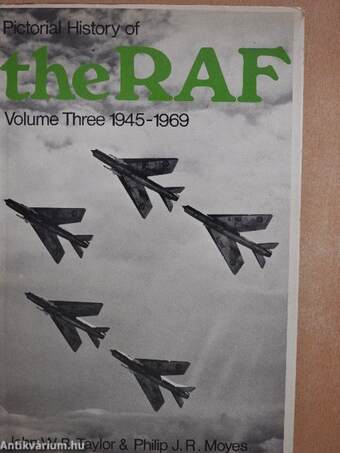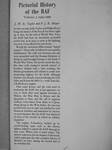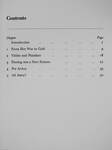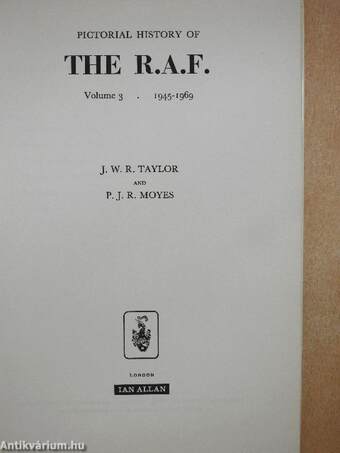1.067.308
kiadvánnyal nyújtjuk Magyarország legnagyobb antikvár könyv-kínálatát

VISSZA
A TETEJÉRE
JAVASLATOKÉszre-
vételek
Pictorial History of the R.A.F. 3
1945-1969
| Kiadó: | Ian Allan Ltd. |
|---|---|
| Kiadás helye: | London |
| Kiadás éve: | |
| Kötés típusa: | Fűzött kemény papírkötés |
| Oldalszám: | 208 oldal |
| Sorozatcím: | |
| Kötetszám: | |
| Nyelv: | Angol |
| Méret: | 23 cm x 16 cm |
| ISBN: | |
| Megjegyzés: | Fekete-fehér fotókkal illusztrálva. |
naponta értesítjük a beérkező friss
kiadványokról
naponta értesítjük a beérkező friss
kiadványokról
Előszó
TovábbFülszöveg
Pictorial History of the RAF
Volume 3 1945-1969
J. W. R. Taylor and P. J. R. Moyes
In this volume John Taylor and Philip Moyes bring the history of the Royal Air Force right up to date. At the end of World War Two, the RAF had been an immensely powerful service but, as inipip, as soon as the fighting was over it was allowed to run down.
Would the victorious Allies remain "united nations"? Those who so believed were quickly disillusioned. The cold war between east and west intensified until the Russian blockade of Berlin in 1948 brought Europe to the brink of World War Three. Air power saved the day, this time with transport aircraft instead of bombers. Despite such a clear warning, the British government still refused to order new sweptwing fighters for the RAF, although America was already mass-producing the F-86 Sabre and Russia the MiG-15—with, basically, a Rolls-Royce engine.
Then came Korea, and the vital need to modernise the RAF was at last apparent—or was its Even... Tovább
Fülszöveg
Pictorial History of the RAF
Volume 3 1945-1969
J. W. R. Taylor and P. J. R. Moyes
In this volume John Taylor and Philip Moyes bring the history of the Royal Air Force right up to date. At the end of World War Two, the RAF had been an immensely powerful service but, as inipip, as soon as the fighting was over it was allowed to run down.
Would the victorious Allies remain "united nations"? Those who so believed were quickly disillusioned. The cold war between east and west intensified until the Russian blockade of Berlin in 1948 brought Europe to the brink of World War Three. Air power saved the day, this time with transport aircraft instead of bombers. Despite such a clear warning, the British government still refused to order new sweptwing fighters for the RAF, although America was already mass-producing the F-86 Sabre and Russia the MiG-15—with, basically, a Rolls-Royce engine.
Then came Korea, and the vital need to modernise the RAF was at last apparent—or was its Even after wars against terrorists in Malaya, the Mau Mau in Kenya and the Egyptians at Suez, and the call to suppress violence everywhere from Aden to Cyprus, Hong Kong to the West Indies, the ten-year period from 1957 to 1967 was marked by such disastrous decisions and indecision by successive governments that the RAF was deprived of most of the aircraft on which its viability depended.
The mighty V-bombers, backed up by world-beating types such as the Hunter fighter, helped to sustain the RAF through its lean years. Where does it stand today? The answer is given in the last chapter of this book, which represents the only complete history of Britain's air force during the second half of its turbulent life.
Vissza
Témakörök
- Idegennyelv > Idegennyelvű könyvek > Angol > Műszaki
- Idegennyelv > Idegennyelvű könyvek > Angol > Művészetek > Fotóművészet
- Idegennyelv > Idegennyelvű könyvek > Angol > Történelem > Európa története > Egyéb
- Művészetek > Fotóművészet > Albumok > Külföldi
- Művészetek > Fotóművészet > Albumok > Tematikus
- Művészetek > Fotóművészet > Idegen nyelv > Angol
- Művészetek > Fotóművészet > Témái > Fotódokumentumok
- Történelem > Idegennyelvű > Angol
- Történelem > Legújabb kor > Egyéb
- Történelem > Hadtörténet > Fegyverek, fegyvernemek
- Történelem > Hadtörténet > Hadügy, hadviselés
- Műszaki > Idegennyelv > Angol
- Műszaki > Hadászat, hadtörténet
Megvásárolható példányok
Nincs megvásárolható példány
A könyv összes megrendelhető példánya elfogyott. Ha kívánja, előjegyezheti a könyvet, és amint a könyv egy újabb példánya elérhető lesz, értesítjük.










